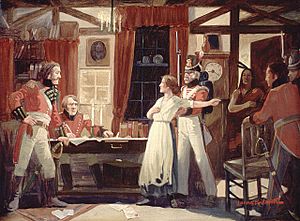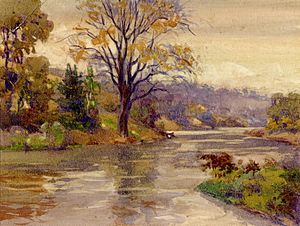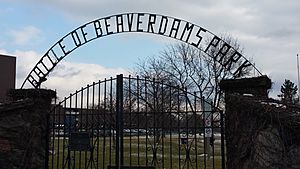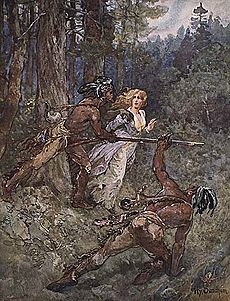Battle of Beaver Dams facts for kids
Quick facts for kids Battle of Beaver Dams |
|||||||
|---|---|---|---|---|---|---|---|
| Part of the War of 1812 | |||||||
 Laura Secord warns James FitzGibbon. |
|||||||
|
|||||||
| Belligerents | |||||||
First Nations |
|||||||
| Commanders and leaders | |||||||
| James FitzGibbon | Charles G. Boerstler | ||||||
| Strength | |||||||
| 400 natives, 50 regulars |
600+ regulars | ||||||
| Casualties and losses | |||||||
| 5–15 killed 20–25 wounded |
25 killed |
||||||
| Official name: Battle of Beaver Dams National Historic Site | |||||||
| Designated: | 1921 | ||||||
The Battle of Beaver Dams happened on June 24, 1813. It was a key event during the War of 1812. American soldiers marched from Fort George. They planned to surprise a British outpost at Beaver Dams.
A brave woman named Laura Secord found out about their secret plan. She walked a long, hard journey to warn the British. Native warriors then ambushed the American troops. The Americans eventually surrendered to a small British group. This group was led by Lieutenant James FitzGibbon. About 500 American soldiers were captured.
Contents
What Was the Battle of Beaver Dams?
How the Battle Started
In May 1813, the United States captured Fort George. The British army had to retreat. They moved to Burlington Heights. This left the Niagara Peninsula open to the Americans.
The Americans tried to chase them. But a British counter-attack stopped them. This happened at the Battle of Stoney Creek. Also, American warships left to protect their own base. British ships then threatened the American supply routes.
So, the Americans went back to Fort George. The British followed them. They set up an outpost at DeCou's house. This house was in what is now Thorold, Ontario. From there, Native warriors and local militia often attacked American outposts.
The American commander at Fort George, General John Parker Boyd, wanted to stop these attacks. He decided to launch a surprise attack on the British outpost at DeCou's house.
The American Plan
Colonel Charles Boerstler led the American attack force. He had about 600 soldiers. These included infantry, artillery, and dragoons. Forty mounted volunteers also joined them. They even brought two large supply wagons.
On the evening of June 23, Boerstler's force moved quietly. They went from Fort George to Queenston. There, they rested in houses and other buildings.
Some American officers stayed at the home of James Secord. His wife, Laura Secord, overheard their plans. Very early on June 22, she decided to warn the British. She walked about 17 miles (27 km) through the woods. She found a Native camp. The warriors took her to Lieutenant James FitzGibbon. He was in charge of the British outpost. Her information helped confirm what the Natives had already seen.
The Battle Unfolds
The main group of Native warriors were 300 Kahnawake (also called Caughnawaga). They were led by Captain Dominique Ducharme. Another 100 Mohawks were led by Captain William Johnson Kerr. They set up ambushes in a thick forest. This was about 1.5 miles (2.4 km) east of Beaver Dams.
Lieutenant FitzGibbon had 46 British soldiers. They were from the 49th Regiment of Foot. They waited in reserve.
On the morning of June 24, the American forces headed for DeCou's house. As they climbed a trail, they realized Natives were all around them. The Natives opened fire. Colonel Boerstler was wounded.
FitzGibbon then stepped in. He spoke to Boerstler under a truce flag. He told Boerstler that the Americans were surrounded. He said if they didn't surrender, he might not be able to stop the Natives. The wounded Boerstler agreed to surrender. He gave up to Major de Haren. De Haren had just arrived with more British soldiers.
The American force surrendered in a field. This field was south of the Thorold Tunnel. The prisoners were taken to DeCou's house. Then they went to the British base at Ball's Falls.
Who Won and What Happened Next?
The Native warriors reported 5 to 15 killed and 20 to 25 wounded. The Americans reported 25 killed and 50 wounded. All the wounded were taken prisoner. A total of 462 American soldiers were captured.
Losing so many soldiers made the Americans at Fort George feel defeated. After this, they rarely sent patrols far from the fort. On July 8, another small group of Americans was ambushed. They lost 28 men. This made them even more afraid of the Native people.
Most of the American soldiers left Fort George in September. This left the fort to local New York militia.
The Story of Laura Secord

After the battle, people told stories about who deserved the most credit. A local saying was, "The Caughnawaga got the victory, the Mohawks got the plunder and FitzGibbon got the credit."
In 1818, FitzGibbon wrote a report. He said that only the Natives fired shots. He said they scared the Americans. His part was to offer them protection from the Natives.
Captain Ducharme, a French Canadian who lived with the Natives, said he didn't demand the surrender himself. This was because he didn't speak English.
Much later, in 1827, FitzGibbon wrote more about Laura Secord. He confirmed that she came to him on June 22. She told him about the American plan. She had walked about 12 miles (19 km) to warn him. Because of her information, he placed his soldiers and Natives to stop the Americans. The Americans didn't come until June 24, but they were captured. The American commander, Colonel Boerstler, confirmed her information.
So, Laura Secord learned of the American plans on June 22. She left her home in St. David's (near Queenston) that day. This was before the main American troops even left Fort George.
Remembering the Battle Today

The Battle of Beaver Dams site was one of the first places considered for a national historical park. In 1914, groups wanted to make a 40-acre site near Thorold a national park.
While it didn't become a national park, the Historic Sites and Monuments Board was created in 1919. This board helps protect historic places. In 1921, they named the Battle of Beaver Dams site a National Historic Site. It was one of their first choices.
A monument for the battle was put up in 1923. It was at the original battle site. This was near Davis Road and Old Thorold Stone Road. In 1976, this monument was moved. It went to Beaverdams Park. This happened because a new canal was planned near the old battlefield. The original site was unmarked for many years. But in 2013, a new "historic boulder" was placed there. This was for the battle's 200th anniversary.
A Special Park and Trail
| Original site: | 43°07′04″N 79°11′08″W / 43.11772°N 79.18550°W |
|---|---|
| Present site: | 43°07′22″N 79°12′06″W / 43.122722°N 79.201547°W |
The "Laura Secord Legacy Trail" opened in June 2013. It follows the path Laura Secord took. She walked from her home in Queenston to DeCew House in Thorold. This is where she gave her warning to Lieutenant FitzGibbon. The trail is 32 kilometers long. It goes through old forest trails and city sidewalks. It is also connected to the Trans-Canada Trail.
Images for kids








